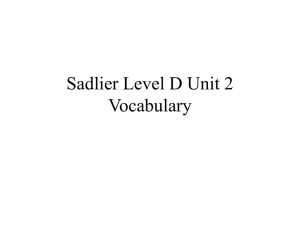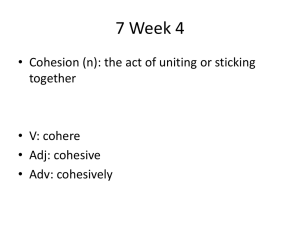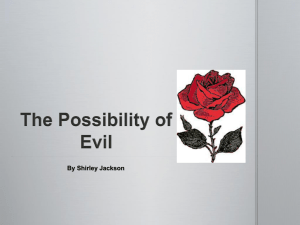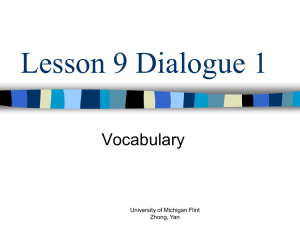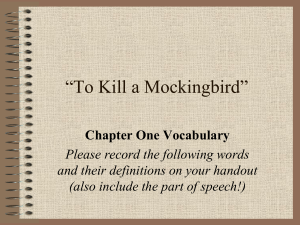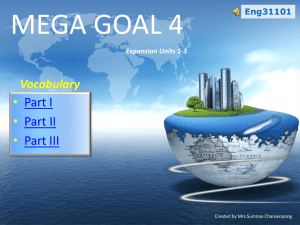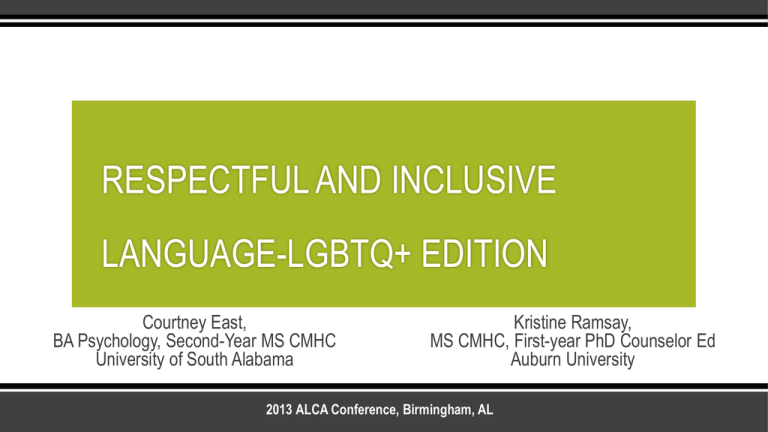
RESPECTFUL AND INCLUSIVE
LANGUAGE-LGBTQ+ EDITION
Courtney East,
BA Psychology, Second-Year MS CMHC
University of South Alabama
Kristine Ramsay,
MS CMHC, First-year PhD Counselor Ed
Auburn University
2013 ALCA Conference, Birmingham, AL
Why should we even care?
Terminology
Genderbread People
Politically Correct VS Inclusive
Inclusive Forms
How to be an ALLY
Resources to check out!
Proof that I didn’t make this all up
DISCLAIMER:
YOU WILL MOST LIKELY BE
CONFUSED AT SOME POINT
DURING THIS PRESENTATION
AND YOU MIGHT EVEN LEAVE
CONFUSED.
That’s OK!...
As long as you don’t choose to
stay confused.
First, A Word From ALGBTICAL
– Counselors are expected to be ethical. They are committed to serving the lesbian, gay, bisexual and
transgender community with integrity and professionalism. They adhere to codes of ethical behavior.
– Ethical counselors do not consider homosexuality a choice. Nor do they consider it a disorder or a disease. They
do not consider their clients sick or confused. They do not consider homosexuality unnatural or immoral. They,
in fact, are proud to be allies, advocates, and activists in behalf of the issues and concerns of their LGBT
and clients.
– Ethical counselors provide professional and compassionate advising, therapy, consultation, and counseling to
LGBT students and clients in a manner that is respectful, affirming, supportive, and non-judgmental.
– Ethical counselors avoid attitudes and behavior that are oppressive to LGBT persons, including homophobia and
heterosexism. They are informed professionals. Their perspectives on LGBT issues are based on solid medical,
psychological, sociological, therapeutic, and scientific research.
– Ethical counselors are proud to label themselves as LGBT-friendly or LGBT-affirming. They would like for
clients and prospective clients to know that they will be treated with respect.
Why Counselors Should Know These
Things
˘ Research has shown countless times that the therapeutic relationship is a key factor in
treatment (put on your Rogers hat for this)
˘ That means positive, unconditional regard, and creating an air of acceptance
˘ That means using respectful and inclusive language all the time and with everyone
˘
That means (at minimum) getting comfortable with a few terms first
˘ We have the opportunity to choose language that promotes self-acceptance in LGBTQ+
clients and also models respect and fairness for others
˘ Our nation is in the midst of an exciting civil rights movement!
˘ Right, but what does this have to do with us?
“ Language plays a central role in the way
human beings behave and think” -(WILLA)
TERMS TO
KNOW ABOUT
Before We Get Started…
▪ GLBT, BLTG, LGBTQ+, LGBTQQ, LBTQIA, LGBTTQQIAANPO…LGBT-lmnop!?!
– I tend to stick with LGBTQ+, Inclusive of everyone, but not explicitly everyone…doesn’t supermarginalize any one group
▪ Use of term “communities” instead of a singular “community”
▪ Scrap the usage of “homosexual”, “lifestyle”, and “life-choice”
▪ Think twice before using term “queer”
Here We Go…
▪ HETERONORMATIVE: (adj) Assumption that heterosexuality is superior to other sexualities and
that it is the norm, meaning that anything different is abnormal
▪ LESBIAN: (noun) Woman with emotional and sexual attraction to persons of the same gender
▪ GAY: (adj) Common word for men with emotional and sexual attraction to other men, but often
used in reference to both genders.
▪ BISEXUAL: (adj) Person with emotional and sexual attraction to both men and women, not
necessarily at the same time or to the same extent (typically in regards to cisgendered people,
not trans* people….debatable)
▪ GENDER BINARY: (noun) Idea that only two genders exist: Male and Female
▪ CISGENDER: (adj) A person who’s gender identity and biological sex were aligned at birth
▪ TRANSEXUAL: (adj) Individual who expresses him/herself and lives as a gender different than
his/her genetic gender at birth.
▪ TRANSGENDER: (noun) Umbrella term that covers a range of identities that transgress social
gender norms (adj) A person who lives as a member of a gender not correspond with their
genetic sex. (May identify as gay, straight, lesbian, bi-, or pan- OR as simply andro-, gyne-, or
skolio-philic)
▪ GENDERQUEER (GENDER NONCONFORMING, NON-GENDER CONFORMING):A person
who redefines or plays with gender, or who refuses gender altogether. A label for people who
bend/break the rules of gender and blur the boundaries
▪ TRANS*: (adj) Umbrella term for people whose gender identity and/or expression differs from
the sex they were assigned at birth. (May identify as descriptor term: transgender, transsexual,
genderqueer, etc.)
▪ INTERSEX: (adj) A person born with sex chromosomes, external genitalia, or internal reproductive systems
that are not considered "standard" for either male or female. The existence of intersexuals is evidence of
the reality that there are not just two sexes and that our ways of thinking about sex is socially constructed.
▪ PANSEXUAL: (adj) A person who is fluid in sexual orientation and/or gender or sex identity.
▪ ANDROGYNOUS: (adj) A gender expression that that has elements of both masculinity or femininity.
▪ AGENDER: (noun) A person who sees themselves as existing without gender. They have no (or little)
connection to the traditional system of gender and no personal alignment with either “man” or “woman”.
▪ ASEXUAL: (adj) Designation or self-designation for people who lack feelings of “sexual attraction” and/or
“sexual desire.” There is debate as to whether this is a “sexual dysfunction” or an actual “sexual
orientation.” The term is also sometimes used as a “gender identity” by those who believe their lack of
sexual attraction places them outside the standard definitions of “gender.”
▪ AROMANTIC: (adj) A person who experiences little or no romantic attraction to others and/or a lack of
interest in forming romantic relationships.
▪ ANDROPHILIC/SEXUAL: (adj) Attraction to men, males, and/or masculinity.
▪ GYNEPHILIC/SEXUAL: (adj) Attraction to women, females, and/or femininity.
▪ SKOLIOPHILIC/SEXUAL: (adj) Attraction to genderqueer and transsexual people and
expression (non-cisgendered people).
GENDERBREAD PERSON
(1st Edition)
GENDERBREAD PERSON
(2nd Edition)
GENDER IDENTITY
▪ Non-gendered-existing without a gender
▪ All about how you think about yourself
▪ Typically form identity by age 4
Expression
▪ Cannot be determined based on biological sex, sexual orientation, or attraction
▪ Can be aligned with bio sex and attraction or not, depends on the individual
▪ Agender- “genderless”; presenting in a neutral manner, neither masculine nor feminine
▪ Androgynous-presenting with some aspects of both masculinity and femininity
Biological Sex
▪ Objectively measurable organs, hormones, chromosomes, etc.
▪ Intersex-born with both male and female characteristics in some
variation
▪ Asex-”without sex”
Distinguishing Intersex Factor
Frequency
Not XX and Not XY
1 in 1,666 births
Klinefelter (XXY)
1 in 1,000 births
Androgen Insensitivity Syndrome
1 in 13,000 births
Partial Androgen Insensitivity Syndrome
1 in 130,000 births
Classical Congenital Adrenal Hyperplasia
1 in 13,000 births
Late Onset Adrenal Hyperplasia
1 in 66 individuals
Vaginal Agenesis
1 in 6,000 births
Ovotestes
1 in 6,000 births
Idiopathic (no discernible medical cause)
1 in 110,000 births
Iatrogenic (caused by medical treatment)
no estimate
5 Alpha Reductase Deficiency
no estímate
Mixed Gonadal Dysgenesis
no estimate
Complete Gonadal Dysgenesis
1 in 150,000 births
Hypospadias (in perineum or penile shaft)
1 in 2,000 births
Hypospadias (between corona and tip of penis)
1 in 770 births
Total number of people whose bodies differ from
standard male or female
1 in 100 births
Total number of people receiving surgery to “normalize” Genital appearance
1 or 2 in 1,000 births
Source: Intersex Society
of North America (2008)
Attraction (formerly Sexual Orientation)
▪ Another main change in the Genderbread Person is the move from “orientation” to “attraction”
▪ This change accompanies sexual and romantic, but also considers emotional and spiritual
attraction
▪ NOT sexually attracted to anyone=Asex
▪ NOT romantically attracted to anyone=Aromantic
GENDER IDENTITY
Sexual orientation, gender expression, and
Biological
Sex
biological sex are not dependent on each other,
but rather, are interconnected
Sexual
Orientation
Gender
Expression
ATTRACTION
ONE MORE TIME…
Gay
GENDER IDENTITY
Cisgender Man
Cisgender Woman
Trans*
Genderqueer
GENDER
EXPRESSION
Masculine
Butch
Feminine
BIOLOGICAL SEX
Lesbian
Male
Bisexual
Female
Pansexual
Intersex
Asexual
Femme
Aromantic
Androgynous
Androphilic
Agender
Gynephilic
Skoliophilic
INCLUSIVE
VS.
POLITICALLY
CORRECT
But aren’t they basically the same…?
POLITICALLY CORRECT
INCLUSIVE
▪ EXTERNALLY driven
▪ INTERNALLY driven
▪ Behaving in a way that will gain approval
from others
▪ Being better to the other person
▪ Compromises value of free speech
▪ Can be equated with censorship
▪ Follows “Platinum Rule”
▪ Is a mind-set
GENDER
INCLUSIVE
FORMS
1. I identify my gender as…
__________ (fill in the blank)
If you don’t need gender, but would
prefer to have
it, here is one way you could do it:
2. I identify my gender as…
[ ] Man
[ ] Woman
[ ] Trans*
[ ] __________ (fill in the blank)
[ ] Prefer not to disclose
If you absolutely need to know gender,
my next easy suggestion
would be to simply remove the “not
disclose” option:
3. I identify my gender as…
[ ] Man
[ ] Woman
[ ] Trans*
[ ] __________ (fill in the blank)
If you’d rather not have a fill in the blank
because it will complicate things (e.g.,
make it harder to sort a spreadsheet),
but you want to be incredibly inclusive
and specific, here’s another suggestion:
4. I identify my gender as…
[ ] Man
[ ] Woman
[ ] Transgender
[ ] Transsexual
[ ] Genderqueer
[ ] Nongendered
[ ] Agender
[ ] Genderless
[ ] Non-binary
[ ] Trans Man
[ ] Trans Woman
[ ] Third-Gender
[ ] Two-Spirit
[ ] Bigender
[ ] Genderfluid
[ ] Transvestite
And if you’d rather have fewer options,
even at the expense of
inclusivity/specificity:
5. I identify my gender as…
[ ] Man
[ ] Woman
[ ] Trans*
And finally, if you need to know sex rather
than gender (the only examples that pop
into my mind for a reason why are
medical), here’s a way you can do it and
still be inclusive:
6. I identify my sex as…
[ ] Female
[ ] Male
[ ] Intersex
[ ] MtF Female
[ ] FtM Male
Other Ways to be Inclusive
▪ Ask for “preferred pronoun” instead of gender
– He/his
– She/her
– Ze/hir (pronounced zee and here)
– They/their
▪ Create a safe zone in your space (office, classroom, school, etc.)
▪ Other ideas??
Let’s Wrap Things Up!
▪ Whatever your client identifies as, go with it! They are free to use
whatever term they are most comfortable with regardless of the
definition you know to be “true”.
▪ There is no way to accurately guess someone’s sexual orientation or
gender based on their appearance. So don’t.
▪ Your “genuine curiosity” doesn’t allow you to question people who
seem different. The session is not about you so fill your curiosity in on
your own time.
FURTHER READING
— ALGBTICAL
— Sam Killerman’s book-The Social Justice Advocate’s Handbook: A Guide to Gender
— GLSEN.org
— HRC.org
— Journal of Gay and Lesbian Mental Health
— Itspronouncedmetrosexual.com
— Wikiqueer.org
— Thesafezoneproject.com
— Transwhat.org
PEOPLE WHOSE IDEAS I BORROWED
Association of Lesbian, Gay, Bisexual, and Transgender Issues in Counseling. (2013). LGBT affirming counselors: Professional
Retrieved from http://www.algbtical.org/2A%20COUNSELING.htm.
Heck, N. C., Flentje, A., & Cochran, B. N. (2013). Intake interviewing with lesbian, gay, bisexual, and transgender clients:
affirmation. Journal of Contemporary Psychotherapy, 43(1), 23-32. doi:10.1007/s10879-0129220-x
Intersex Society of North America. (2008). How common is intersex? [data set]. Retrieved from
and ethical.
Starting from a place of
http://www.isna.org/faq/frequency.
Killerman, S. (2013). The social justice advocate’s handbook: A guide to gender. Austin, TX: Impetus Books.
Lemoire, S. J. & Chen, C. P. (2005). Applying person-centered counseling to sexual minority adolescents. Journal of
Development, 83, 146–154. doi: 10.1002/j.1556-6678.2005.tb00591.x
Weinburg, M. (2009). LGBT-inclusive language. English Journal,
98(4), 50-51.
Counseling &


